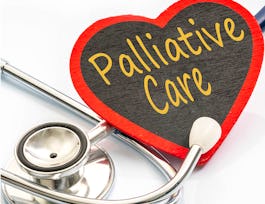In this course, you will be able to develop a systems view for assessing and managing pain in the palliative care setting. By the end of the course, you will be able to: 1) Describe the pain problem in the palliative care setting; 2) Assess a person’s pain, 3) Explain the benefits of integrative therapies and pharmacologic strategies to manage pain.



Pain Management: Easing Pain in Palliative Care
This course is part of Palliative Care: It's Not Just Hospice Anymore Specialization



Instructors: Regina Fink
Sponsored by Coursera Learning Team
7,377 already enrolled
(181 reviews)
Skills you'll gain
Details to know

Add to your LinkedIn profile
5 assignments
See how employees at top companies are mastering in-demand skills

Build your subject-matter expertise
- Learn new concepts from industry experts
- Gain a foundational understanding of a subject or tool
- Develop job-relevant skills with hands-on projects
- Earn a shareable career certificate


Earn a career certificate
Add this credential to your LinkedIn profile, resume, or CV
Share it on social media and in your performance review

There are 5 modules in this course
In this module, you will review pain assessment basics. You will start with defining pain and the scope of the pain problem in the palliative care setting. You will review various pain types and causes of pain in people with serious illness. To understand how pain medications and integrative pain therapies work to decrease pain, you need to know how the body recognizes pain and makes a person hurt. Common barriers to good pain management and myths and misconceptions will be discussed. You will review how to evaluate a person’s pain and how to know if persons are having pain when they cannot tell you. Remember pain is a personal experience.
What's included
8 videos9 readings1 assignment
In this module, you will review the many dimensions that can affect the way pain is expressed and how it responds to treatment. You will also review various integrative therapies or healing practices that focus on the relationship between the provider and whole person, including the mind, body, and spirit, to improve health, healing, and pain. You will start with defining complementary and alternative therapies and understanding the difference between the two. You will review four integrative health domains as defined by the National Center for Integrative Health which is part of the National Institutes of Health. Finally, you will evaluate the best evidence about the use of these therapies in managing pain in people with serious illness. Remember, it is important to ask patients if they use integrative health therapies. Try to understand their past experiences and attitudes toward non-drug treatments. The key is to find out what works for the person in pain with his/her unique characteristics. As caregivers we need to be open to various approaches and our patient’s wishes.
What's included
6 videos6 readings1 assignment
When people have pain their quality of life can be poor and they can experience more suffering. In this module, you will learn about non-opioid medications that can be used to treat pain and ease suffering.
What's included
4 videos3 readings1 assignment
When people have pain their quality of life can be poor and they can experience more suffering. In this module, you will learn about opioid medications that can be used to treat pain and ease suffering.
What's included
5 videos4 readings1 assignment
In this module, you will review a case study of Mrs. Ana Garcia, a mock patient diagnosed with cervical cancer. Listen to her story and think about what you would do to advocate for her and help her pain. You will answer questions based on your new knowledge and skills you have learned from modules 1 to 4. This summative assessment has two parts. First, you will answer seven questions reflecting on material presented in the first two modules of our course, “Easing Pain.” Once you successfully pass the first part of the summative assessment, answer the next 8 questions about Anna’s case based on materials learned from modules 3 and 4. Good luck!
What's included
1 video1 assignment
Instructors


Offered by
Why people choose Coursera for their career




Learner reviews
181 reviews
- 5 stars
83.97%
- 4 stars
13.25%
- 3 stars
2.20%
- 2 stars
0%
- 1 star
0.55%
Showing 3 of 181
Reviewed on Apr 17, 2020
This course presented a lot of valuable information in an easy to understand and engaging format. Thank you!
Reviewed on Apr 21, 2019
I found this course so very useful in gaining information about pain management. Very informative and a pleasure to work my way through the course. My thanks to the educators and course organisers.
Reviewed on Jul 9, 2020
Well organized and helpful. Would definitely take another class.
Recommended if you're interested in Health

University of Colorado System

University of Colorado System

Stanford University

Stanford University

Open new doors with Coursera Plus
Unlimited access to 10,000+ world-class courses, hands-on projects, and job-ready certificate programs - all included in your subscription
Advance your career with an online degree
Earn a degree from world-class universities - 100% online
Join over 3,400 global companies that choose Coursera for Business
Upskill your employees to excel in the digital economy




